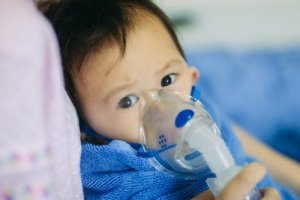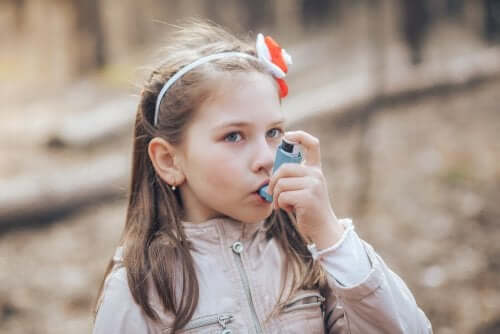Asthma Treatment in Children: What You Should Know

Asthma is one of the most frequent chronic diseases during childhood. It’s a public health problem that has been increasing in recent years and leads to the consumption of large amounts of drugs. Thus, in this article, we’ll focus on what you should know about asthma treatment in children.
What is asthma?
Asthma, according to the III International Pediatric Consensus, is a disorder characterized by “recurrent wheezing and permanent coughing in a situation where asthma is possible and other less frequent diseases have been ruled out.”
The most common symptoms of an asthma attack are the following:
- Wheezing.
- Dyspnea.
- Cough.
- Thoracic oppression.
- Obstruction of the airways.
- Bronchial hyper-reactivity.
- Inflammation of the airway.
Asthma treatment in children
Asthma treatment is generally divided into two large blocks. On the one hand, we have the treatment of acute crises and, on the other, the chronic maintenance treatment. The main goals of asthma treatment in children are:

- Reducing and trying to eliminate chronic symptoms.
- Preventing the onset of acute crises.
- To avoid as much as possible the use of drugs and their side effects.
The main drugs used in the treatment of asthma in children are:
- Bronchodilators, for symptom relief.
- Anti-inflammatory, to control the disease.
Treatment of an acute asthma attack
When we’re facing an acute crisis, the objectives of the treatment change and the most important thing is to treat hypoxemia; the decrease in the pressure of oxygen in the blood. In fact, this is the first assessment carried out in a child who presents an asthmatic crisis situation.
To perform the assessment of the partial pressure of oxygen in arterial blood, doctors use a pulse oximeter that measures oxygen saturation. Thus, depending on the results, they can classify the crisis according to its severity:
- Mild: O2 saturation is greater than 94%.
- Moderate: O2 saturation is between 91% and 94%.
- Severe: O2 saturation is less than 91%.
They classify it as hypoxemia when the partial pressure of oxygen in arterial blood decreases below 91% or 60 mmHg. In these cases, the child should be referred urgently to a hospital. The same goes when there is a risk of complications, a history of high risk, or lack of response to treatment.
In the event of an acute crisis, the treatment used as the first option is the administration by inhalation of beta-2-adrenergic drugs. They’re administered with a pressurized chamber inhaler system or with a nebulizer. The most commonly used drug is salbutamol. Other options may be ipratropium bromide or corticosteroids.

The administration of oxygen is necessary for all patients with an oxygen saturation of less than 94%. Hence, they must be referred to a hospital to be checked and controlled more thoroughly.
Maintenance treatment of asthma in children
When we talk about chronic maintenance treatment, it’s very important to consider the child’s age. Generally, apart from pharmacological treatment, doctors assess the option of immunotherapy and their education places special emphasis on the management of disease and crises.
As we mentioned before, during the treatment of asthma in children, we must avoid the chronic consumption of drugs as much as possible. You must start with a basic treatment that can be gradually increased, if necessary.
The most commonly used drugs as asthma maintenance treatment are inhaled corticosteroids, such as budesonide or fluticasone. It’s important to control corticosteroid doses to avoid undesirable side effects. If you have to increase the dose, it’s advisable to combine them with bronchodilators.
Keep in mind that most asthma attacks in children under the age of 3 are due to viral infections. The symptoms disappear regardless of the treatment, so you shouldn’t abuse unnecessary drugs that can cause more damage than benefits.
Asthma is one of the most frequent chronic diseases during childhood. It’s a public health problem that has been increasing in recent years and leads to the consumption of large amounts of drugs. Thus, in this article, we’ll focus on what you should know about asthma treatment in children.
What is asthma?
Asthma, according to the III International Pediatric Consensus, is a disorder characterized by “recurrent wheezing and permanent coughing in a situation where asthma is possible and other less frequent diseases have been ruled out.”
The most common symptoms of an asthma attack are the following:
- Wheezing.
- Dyspnea.
- Cough.
- Thoracic oppression.
- Obstruction of the airways.
- Bronchial hyper-reactivity.
- Inflammation of the airway.
Asthma treatment in children
Asthma treatment is generally divided into two large blocks. On the one hand, we have the treatment of acute crises and, on the other, the chronic maintenance treatment. The main goals of asthma treatment in children are:

- Reducing and trying to eliminate chronic symptoms.
- Preventing the onset of acute crises.
- To avoid as much as possible the use of drugs and their side effects.
The main drugs used in the treatment of asthma in children are:
- Bronchodilators, for symptom relief.
- Anti-inflammatory, to control the disease.
Treatment of an acute asthma attack
When we’re facing an acute crisis, the objectives of the treatment change and the most important thing is to treat hypoxemia; the decrease in the pressure of oxygen in the blood. In fact, this is the first assessment carried out in a child who presents an asthmatic crisis situation.
To perform the assessment of the partial pressure of oxygen in arterial blood, doctors use a pulse oximeter that measures oxygen saturation. Thus, depending on the results, they can classify the crisis according to its severity:
- Mild: O2 saturation is greater than 94%.
- Moderate: O2 saturation is between 91% and 94%.
- Severe: O2 saturation is less than 91%.
They classify it as hypoxemia when the partial pressure of oxygen in arterial blood decreases below 91% or 60 mmHg. In these cases, the child should be referred urgently to a hospital. The same goes when there is a risk of complications, a history of high risk, or lack of response to treatment.
In the event of an acute crisis, the treatment used as the first option is the administration by inhalation of beta-2-adrenergic drugs. They’re administered with a pressurized chamber inhaler system or with a nebulizer. The most commonly used drug is salbutamol. Other options may be ipratropium bromide or corticosteroids.

The administration of oxygen is necessary for all patients with an oxygen saturation of less than 94%. Hence, they must be referred to a hospital to be checked and controlled more thoroughly.
Maintenance treatment of asthma in children
When we talk about chronic maintenance treatment, it’s very important to consider the child’s age. Generally, apart from pharmacological treatment, doctors assess the option of immunotherapy and their education places special emphasis on the management of disease and crises.
As we mentioned before, during the treatment of asthma in children, we must avoid the chronic consumption of drugs as much as possible. You must start with a basic treatment that can be gradually increased, if necessary.
The most commonly used drugs as asthma maintenance treatment are inhaled corticosteroids, such as budesonide or fluticasone. It’s important to control corticosteroid doses to avoid undesirable side effects. If you have to increase the dose, it’s advisable to combine them with bronchodilators.
Keep in mind that most asthma attacks in children under the age of 3 are due to viral infections. The symptoms disappear regardless of the treatment, so you shouldn’t abuse unnecessary drugs that can cause more damage than benefits.
All cited sources were thoroughly reviewed by our team to ensure their quality, reliability, currency, and validity. The bibliography of this article was considered reliable and of academic or scientific accuracy.
- Escribano Montaner, A., Ibero Iborra, M., Garde Garde, J., Gartner, S., Villa Asensi, J., & Pérez Frías, J. (2003). Protocolos terapéuticos en asma infantil. Protocolos Diagnóstico-terapéuticos AEP. Neumología y Alergia. Madrid: Asociación Española de Pediatría, 187-210.
- Laita, J. C., Fernández, J. D. B., Montaner, A. E., Benítez, M. F., de la Rubia, S. G., Garde, J. G., … & Martínez, C. P. (2007, September). Consenso sobre tratamiento del asma en pediatría. In Anales de Pediatría (Vol. 67, No. 3, pp. 253-273). Elsevier Doyma.
- de Arriba Méndez, S., Pellegrini Belinchón, J., Ortega Casanueva, C. (2016). Tratamiento del niño asmático. Pediatr Integral; XX (2): 94-102.
This text is provided for informational purposes only and does not replace consultation with a professional. If in doubt, consult your specialist.








